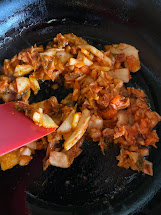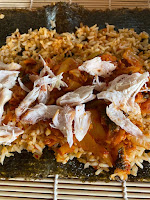  |
| Stir fried kimchi (left) and my favorite ramen |
I started on my current weight loss journey in about 2019. Something that has always been a challenge for me is getting more veggies into my diet. I'm just not a fan. Or at least I wasn't. Korean food has changed my view on vegetables and helped me change the entire way I eat. And while there are still some vegetables that I just don't enjoy (I'm looking at you tomato and any color pepper), there are many more that I have learned how to eat and enjoy on a regular basis. How did that happen? Well, let me try to explain...
 |
| Cabbage and tofu jeon |
It began with watching people cook and eat on Korean television shows. If you've ever seen a Korean variety show, you know that they make nearly every food they eat look delicious. Whether it's ramen, soup, rice, kimchi, pizza, chicken or whatever, it looks like it's the most delicious food they've ever had. And because they are so excited about the way it tastes, it made me curious about it myself. As I watched shows like "Chef and My Fridge" or "Delicious Rendezvous", foods that I never had any interest in trying, like kimchi or seafood, all of the sudden looked too tasty to pass up. Since Korean restaurants are not plentiful where I live, I started learning how to cook the foods I had seen on tv and sure enough...they were delicious.
Slowly things that had never been a part of my diet before, (like cabbage, kimchi, riced cauliflower, spinach, carrots, green onion and more) started entering my diet on a daily basis. Spices that I'd never used were also introduced. Spices like gochugaru (red pepper powder), gochujang (red pepper paste), and sesame oil. On Weight Watchers, vegetables are 0 point foods so that means you can basically eat as much of them as you like. So these foods not only were introducing more nutrients to my body, but keeping me from getting hungry as well.
I learned how to make kimchi jiggae (a jiggae is a stew), jeon (a savory vegetable pancake), stir fry dishes, and lots of other things that easily filled me up, but were low in points. The more Korean cooking shows and YouTube channels I watched, the more things I wanted to try. Don't get me wrong. Not all Korean food is diet friendly. Some of it is very high is calories. But, as I would work out the recipes, I'd exchange higher point items for lower point ones and eventually found a host of Korean or Korean inspired foods that I could make for myself that would be delicious, but also fit into my diet plan.
Here is just one example. Gimbap is a Korean staple...along the same lines as Americans would think of a sandwich. The ingredients inside can vary, but the main one is rice. Rice is high in points but you need a lot of it to make gimbap properly. So, I use part rice and part cauliflower rice. When it is seasoned together it works great. Then it's just a matter of adding other ingredients. For the version pictured below, I used baked chicken and stir fried kimchi. You roll it up in a seaweed wrap and voila!
 |
| Gimbap after it's rolled. |

Gimbap before it's rolled.
This change in eating wasn't something that happened quickly. It took me a couple years to totally change my eating habits and I also include exercise, but I did eventually lose 100lbs. I gained a little when I took my trip to Korea and over the holidays, but I'm in process of getting that back off and headed toward my goal weight once again. I still have about 60lbs to lose before I hit my final goal. But I'll do it. I've already come a long way. You can see the change in my face story below. If you have questions or want some more fun lower point Korean food tips, let me know. I'm always glad to share what I've learned.






Excellent, Toni! I salute you as you continue on your journey!
ReplyDeleteThank you! :-)
DeleteFun post, Toni. I need to at some point figure out some low-carb but also not spicy Korean food. I love bibambap, but I've never made it. Also, lots of rice.
ReplyDeleteYou could mix some cauliflower rice with the regular rice or just use cauliflower rice in the bibimibap. It's super easy to make because you can literally use whatever veggies you have handy. I love it too.
Delete